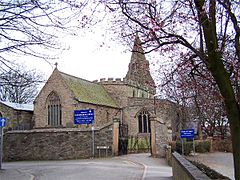Powerflush nearby to Shepshed
 Shepshed, also known as Sheepshed until 1888, (also Sheepshead – a name derived from the village’s heavy involvement in the wool industry) is a town in Leicestershire, England, with a population of 13,505 according to the 2011 census. It is part of the Charnwood borough local authority, and Shepshed is the second largest settlement after Loughborough.
Shepshed, also known as Sheepshed until 1888, (also Sheepshead – a name derived from the village’s heavy involvement in the wool industry) is a town in Leicestershire, England, with a population of 13,505 according to the 2011 census. It is part of the Charnwood borough local authority, and Shepshed is the second largest settlement after Loughborough.
Domont, a Parisian suburb, is twinned with the town.
Visit this for powerflushing service in your heating systems in these postcode areas:
HISTORY
Origins
The town began as a centre for the wool trade. However, it has become a dormitory town for Loughborough, Leicester, Derby, and Nottingham since the construction of the M1 motorway nearby. It was officially a village until recently, and it claimed to be Britain’s largest, as well as having the most pubs per capita in the country. However, as of 2021, it only has twelve public houses.
There has been some debate about the origins of the town’s name. Scepeshefde Regis, as mentioned in the Domesday Book of 1086, means “(King’s) hill where sheep graze,” but there have been many changes since then until the current form, Shepshed, was adopted in 1888. The addition of the suffix ‘Regis’ indicates that the area once housed a royal lodge.
Before the Domesday Book, there is little information about the settlement on the site of Shepshed, but the name is unmistakably Anglo-Saxon: local history books claim that Shepshed has two of the country’s oldest roads, Ring Fence and Sullington Road, the latter being an ancient British track named after the goddess Solina. Anglo-Saxon Shepshed couldn’t have been much more than a hamlet in a vast forest district. However, subsequent centuries provide a wealth of historical material. The wool industry was central to mediaeval Shepshed’s prosperity, and “Well Yard” on Forest Street could be a corruption of “Wool Yard,” where Bradford wool merchants gathered to buy from locals. Furthermore, there is substantial evidence that a weekly market was held, at least until the 14th century.
St Botolph Parish Church
The parish church of St Botolph (the westernmost parish church in England to bear the name) was built in the 11th century[citation needed]. After the Norman conquest in 1066, Odo of Bayeux, William the Conqueror’s half-brother, was given the land known as Oakley Wood. The estate was returned to the Crown several times, including in 1534. A wood carving in the church depicts Queen Elizabeth I’s visit, though it is unclear if the Queen ever came to Shepshed, but if she did, it would have been the Queen’s farthest northward journey in the country. [Citation required] The church is still the focal point of the town’s older section.
Leicester Abbey was the church’s original patron. However, between 1699 and 1856, the patrons were the Phillips family of Garendon Hall. Since Sir Ambrose Phillips (1637–1691) purchased the manor in 1683, this family has been Lords of the Manor. Garendon Hall (demolished 1964) was built on the site of Garendon Abbey, a prominent Cistercian house founded in 1133 by Robert de Beaumont, 2nd Earl of Leicester and surviving until Henry VIII’s dissolution in 1536. Garendon Abbey, whose economy was primarily based on sheep farming, was one of Leicestershire’s most important grange owners.
the 18th to the 20th centuries
The common lands around Shepshed were enclosed in the 18th century. There had been enclosures in the 15th and 16th centuries,[citation needed], but by the end of the 18th century, the last remaining common land, about 2,000 acres (8 km2), had been enclosed and divided among the village’s principal commoners. In 1753, 85 bays of buildings in the town were destroyed by fire, which occurred at what is now known as Hallcroft, named after the school that was burned down in the fire.
During the nineteenth century, there were numerous changes. When the Charnwood Forest Canal opened in 1798, it briefly connected Shepshed to Loughborough and the coalmines of West Leicestershire, but its success was short-lived. The dam at Blackbrook Reservoir, south of Shepshed, part of the doomed canal scheme, collapsed the following year, causing widespread flooding in Shepshed and Loughborough. By 1804 the canal had proven to be an unprofitable venture and had been abandoned, though modern roads and footpaths still follow the canal’s path through Shepshed. The Charnwood Forest Railway (nicknamed the Bluebell Line due to the flower’s proliferation) opened in 1883, but regular passenger services ended in 1931. However, the goods service did not cease operations until 1963. Shepshed railway station no longer exists, but a portion of the old line, including the now-defunct Grace Dieu viaduct, serves as a bridleway between the town and Thringstone.

